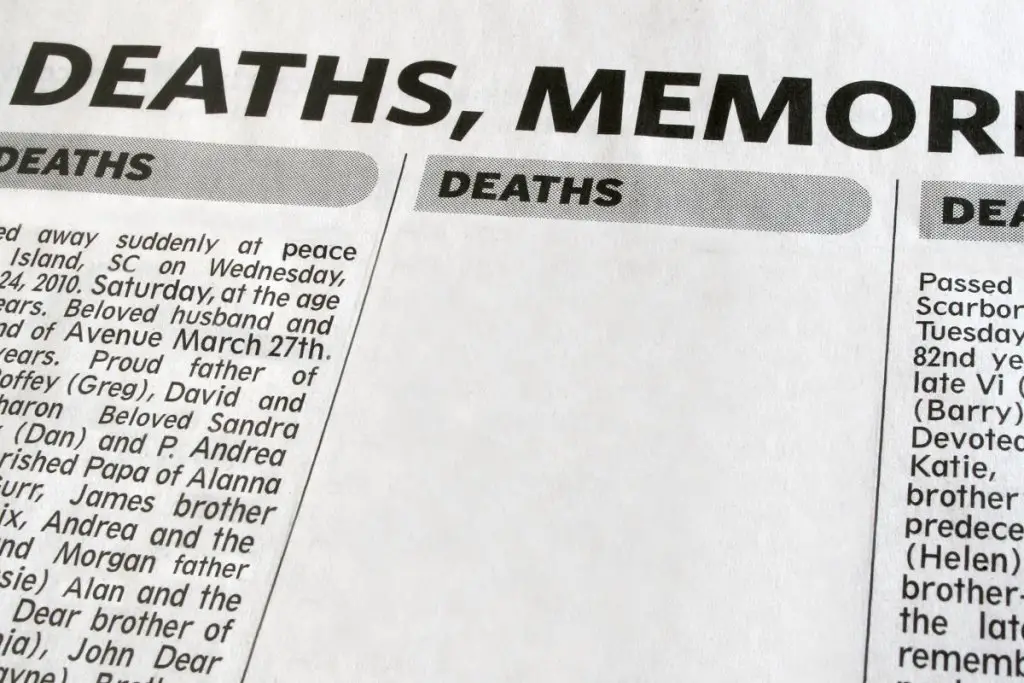An obituary contains information about the funeral services and the deceased. Using an obituary template provides an easy way to create newspaper obituaries or obituary programs in the proper format. These templates ensure that you share pertinent information and showcase the life of the deceased.
Writing an obituary for a recently deceased loved one can be a difficult task. Regardless of the cause of death or circumstances related to it, the passing away of a family member or close friend can be difficult to process.
While there are always different approaches and ways to do anything, some people prefer following a template or looking at examples of other obituaries to guide them. This can help relieve stress and help speed up the process of writing an obituary and help you write a traditional and appropriate one.

Table of Contents
What Do You Include In An Obituary?
Essential details about that person’s life important to list in an obituary include their full name, their place of birth and place of death, and date of birth and date of death.
Adding information such as a spouse’s name and names of their children, grandchildren, or even great-grandchildren can help paint a brief picture of that individual’s life.
Many short obituaries intended for publication in a newspaper stop at this point, as adding more information can drastically increase the cost. Obituaries that will be used as part of the funeral program put on the funeral home website or provided to organizations the deceased belonged to for inclusion in their newsletters can be more detailed.
Longer obituaries might include relevant details such as their place of residence, important milestones in their life such as when they graduated from high school or college, details of military service, employment and jobs held, honors or distinctions, education background, and any hobbies or involvement they had in their community.
After the biographical information, funny or interesting stories or events can be added as examples of what was important to the deceased and how they lived their life. Sharing stories or events is often a great way to make the obituary come to life.
The information assembled for the obituary can then be used when giving the eulogy at the funeral service. Communicating loving memories and relevant biographical information is the main purpose of both an obituary and a eulogy, and writing one can help with the other.

Are There Templates To Follow For Obituary Writing?
A variety of obituary templates can be used to help with writing an obituary for your father, mother, or other deceased loved one. Often, you can find a blank obituary template online where all you need to do is fill in the basic information indicated in the template.
These templates help organize the information about your deceased person so that whether you write a short obituary or a longer one, it will be laid out properly for the newspaper.
Following a template is not a necessary part of writing an obit. Many people choose to write obituaries on their own, and that is also perfectly fine. What is essential is including the basic information that the person died and the details about the services.
Reading examples of obituaries that others have done can also give you ideas of what to include and how to make the details interesting. Using a template facilitates your obituary writing. There are templates available for those who are unsure of where to start or who want to make sure they follow tradition and write something appropriate for their deceased loved one.
Why Use An Obituary Template?
Working with the funeral home, coordinating the order of service, and dealing with grieving family members are all time-consuming tasks. Planning out key details of the service, choosing the right pallbearers, coordinating with family members, and setting up the funeral reception take up time and money.
Following a template can be a time saver and stress reliever. Taking the pressure off of writing an obit frees up an individual’s time to take care of all of the details that accompany a funeral service.
A template can help you zero in on what you want to say about the main reason for the obituary: the death of your loved one. It will also help you remember the details you want to include.
An obituary template can often ease the burden, as you can easily see what to include. Instead of thinking through and creating something new, it can be easier and less stressful to work off something that has already been laid out.
What Should You Omit From The Obituary?
Detailed obituaries make great mementos for fellow mourners and offer insights about the deceased. The downside of obituaries published in newspapers and online is that they provide information to identity thieves and other scammers.
The AARP advises leaving out details such as the deceased’s date and place of birth, exact address, middle name, maiden name, and mother’s maiden name.
A stripped-down obituary might include:
- Age
- Any familial survivors
- Education
- Vocation
- When the person retired, if relevant
- Any military affiliations
- Any volunteer affiliations
- Date, time, and location of the funeral
- Any viewing details
- Requests for donations in lieu of flowers
Including the general cause of death is optional, but doing so answers any questions mourners may have without going into excessive detail. Saying the person died “after a long battle with cancer” or “kidney failure” is sufficient.
The obituary should skip over family rifts, illegal activities, and any personal details you don’t want to be public knowledge.
Future generations of family historians and genealogists will be unhappy if obituaries omit basic details such as the date of birth and the mother’s maiden name. However, it is up to you to determine what you want to include.

How Do You Find A Free Obituary Template?
The easiest way to find a free obituary template is to look online. Many funeral homes and websites devoted to funeral planning offer easy-to-use templates to follow. A quick search online often yields several examples of free-to-download templates you can follow.
Looking up other people’s obits can also be a great way to approach writing one. Finding an obituary that is laid out in a way that you think is appropriate, memorable, or even entertaining and then laying out your specific information is a great way to approach writing a fitting tribute.
Following an obituary, for example, is a tremendous help in preparing an obituary.

